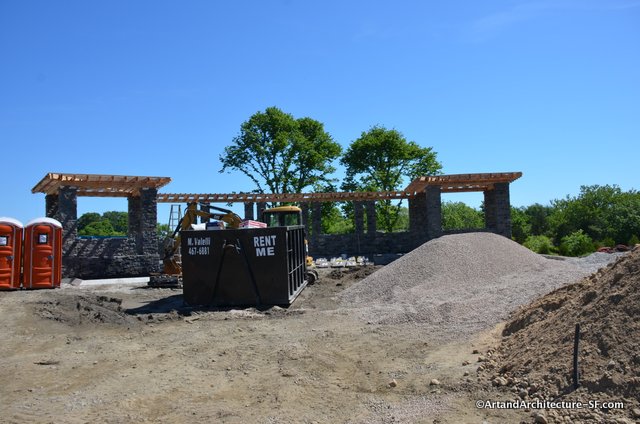School has finished and I am spending a few days with dearest friends Robert and Gail Ornstein. Robert is an architect in Providence, and is working on the restoration of Blue Garden, a Frederick Law Olmsted garden, and as architects who visit with other architects know, I had to see the sight and Robert was thrilled to show it off.
“Once celebrated as the crowning achievement of America’s Gilded Age gardens when it was dedicated in August of 1913, the Blue Garden took its place at the pinnacle of landscape design.”
The garden was originally part of the Commodore Arthur Curtiss James estate, which was known as Beacon Hill. Built in 1909 it was designed by Harriet James, Arthur’s wife, and then the plans were turned over to architects Howells and Stokes.
The main home burned down in 1967 and the grounds fell into disrepair. The land was subsequently purchased and subdivided.
The garden property is now owned by philanthropist Dorrance “Dodo” Hamilton, and it is Mrs. Hamilton that is restoring the Blue Garden.
The south portico was torn down during the 1960’s. However, it had been redesigned from the exedra design sometime in the 1920’s.
 The blue tiles and parts of the coping are original. These were found during excavation for a new home recently built on the property.
The blue tiles and parts of the coping are original. These were found during excavation for a new home recently built on the property.
Above is the original paving from the north portico, as shown below.
There is not doubt this will be a magnificent spot when construction is finished, and it is so nice to see an Olmsted garden of this high quality being brought back.
We had the pleasure of running into Peter Borden, the executive Director of the SVF Foundation. He was, coincidentally, showing John Tschirch, our guide at Marble House, around Blue Garden.
Peter was kind enough to give us a tour of Surprise Valley. When the Commodore inherited his father’s prized herd of Guernsey cattle, he hired Grosvenor Atterbury and Stowe Phelps to design Surprise Valley. This was the era in history of the gentleman’s farm remember.
The farm consists of many buildings including, during those days, a dairy, a slaughterhouse, a smoke house, a piggery, hen houses, a root cellar and a few cottages. In its heyday after WWI it employed more than 100 people.
Today it is so much more. Mrs. Hamilton purchased this property and today it is the SVF Foundation. SVF stands for Swiss Village Farm. When the Commodore and his wife Harriet were alive they traveled extensively, and enjoyed the architecture of Italy and Switzerland. When they built Surprise Valley they incorporated those types of architecture.
After a two year restoration of the Swiss Village it became the headquarters for SVF. SVF is a nonprofit that collaborates with Tuft Cummins School of Veterinary Medicine. The foundation works in cryopreservation of rare and endangered breeds of livestock, it is state-of-the art and jaw dropping what they are working on.
This consists of the collection of germplasm (semen and embryos) and then cryogenically freezing the specimens.
These delightful signs, replications of originals, are all over the farm.
The chicken coop is just fabulous. While chickens are not part of the program, they grow many different types, because what is a farm without chickens?
SVF offers numerous educational programs, including: K-12 school field trips, large animal reproductive studies for fourth-year veterinary students and undergrad internships.
This is the old Smokehouse/Slaughterhouse, it is now the cottage of the Farm Manager.
 The front door gate – the gate folds up into the tower.
The front door gate – the gate folds up into the tower.
Surprise Valley is a terrific spot, doing great things, here is a paragraph from their website:
Rare or heritage breeds of livestock carry valuable and irreplaceable traits such as: resistance to disease and parasites, heat tolerance, mothering ability, forage utilization, and unique flavor and texture qualities. A particular breed that now dominates the marketplace may find its future jeopardized for any number of reasons. For instance, highly inbred and genetically uniform breeds, which dominate the industry, could be decimated by a serious infectious disease. Recall the Irish potato famine: A single variety of potato, which sustained a population, was devastated by blight. Alternatively, consumer preference could shift toward different flavors, textures or agricultural practices. With the lack of diversity in today’s animal agriculture, we are at tremendous risk.

















